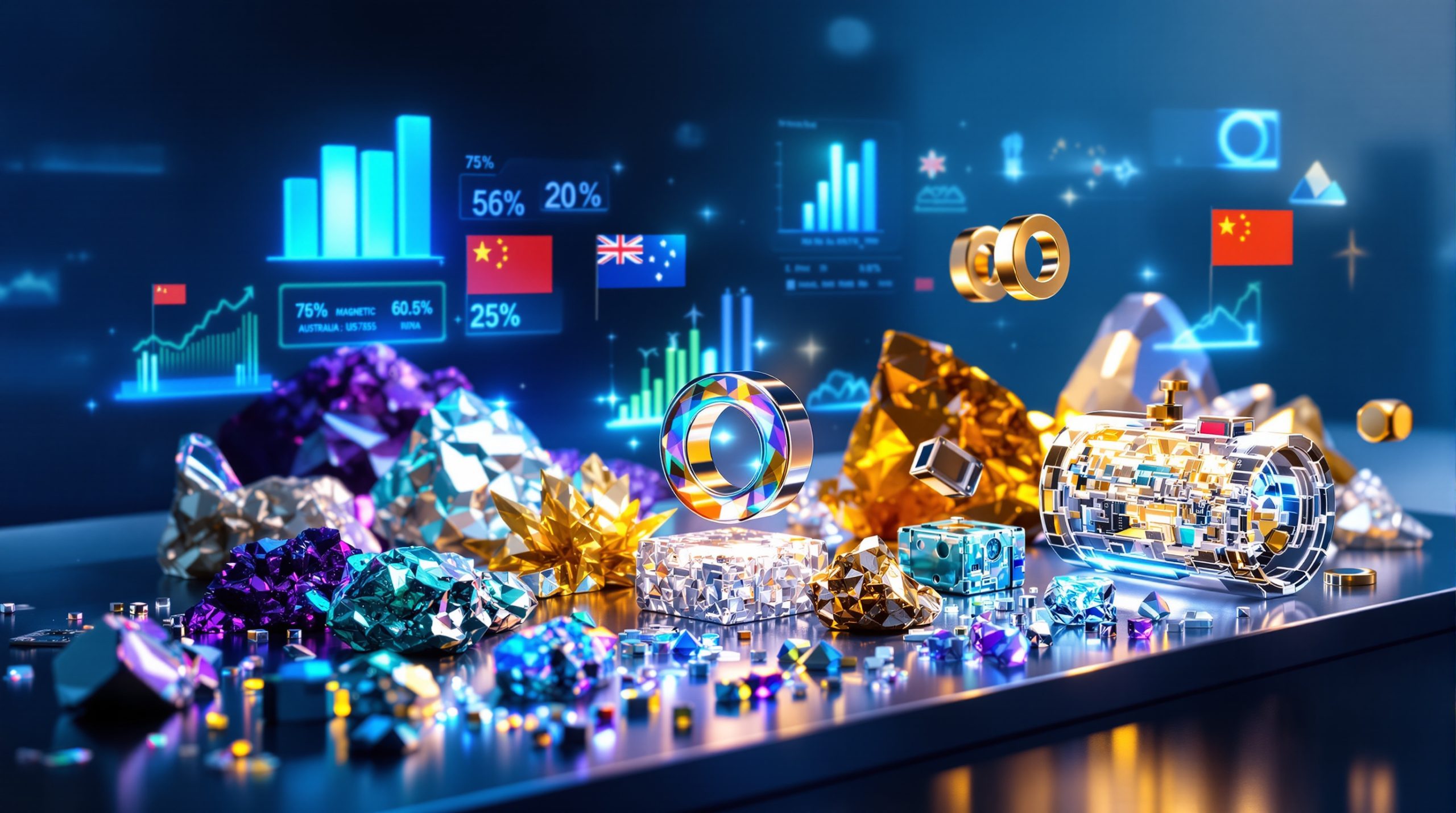The Silver Industrial Revolution: How Manufacturing Demand is Reshaping Global Supply Dynamics
What's Driving the Unprecedented Surge in Silver Demand?
The silver market is experiencing a fundamental transformation as industrial consumption has dramatically increased from just 10% of global production a century ago to 50% today. This shift represents one of the most significant changes in precious metals markets, transforming silver from primarily a monetary metal to an essential industrial commodity with dual demand drivers.
The electrification revolution and renewable energy transition are creating unprecedented demand for silver's unique properties, particularly its superior electrical conductivity and thermal characteristics. These properties make silver irreplaceable in advanced technologies including solar panels, electric vehicles, electronics, and renewable energy infrastructure.
Silver's conductivity exceeds that of any other metal, making it essential in applications where efficiency and reliability are paramount. The metal's unique combination of properties—including its resistance to corrosion, excellent thermal conductivity, and remarkable ductility—creates a perfect storm of silver demand surge and industrial consumption that cannot be easily substituted with alternative materials.
As Shawn Khunkhun, CEO of Dolly Varden Silver, explains: "Industry has come into the market and is now consuming half of the silver that we're mining and recycling. This represents a structural shift that fundamentally changes market dynamics."
How Severe is the Current Supply-Demand Imbalance?
The Growing Structural Deficit
A persistent supply-demand imbalance has emerged with annual deficits of approximately 200 million ounces sustained over five years. This deficit occurs despite silver trading near multi-year highs, indicating robust underlying demand fundamentals that aren't easily resolved by price signals alone.
The current supply structure creates significant constraints:
| Silver Supply Sources | Percentage of Global Output |
|---|---|
| Primary Silver Mines | 25% |
| Byproduct from Base Metal Operations | 75% |
Annual mining production reaches approximately 850 million ounces, supplemented by 150 million ounces from recycling, against total demand exceeding 1.2 billion ounces. This structural deficit appears likely to persist as industrial applications continue expanding while supply growth remains constrained.
What makes this deficit particularly challenging is the inelasticity of silver supply. Unlike gold, where higher prices can directly stimulate dedicated mining projects, three-quarters of silver production comes as a byproduct from operations primarily focused on base metals. This creates a fundamental disconnect between silver demand signals and production response.
Supply Constraints Creating Market Opportunities
The supply structure presents unique challenges when increased silver demand cannot be easily met by requesting higher production from miners whose primary interest lies in base metals like copper, lead, and zinc. This creates a fundamental disconnect between demand signals and supply response capabilities.
"When silver demand increases, operators cannot simply request higher production from miners whose primary interest lies elsewhere."
Geopolitical challenges in major producing regions compound these supply constraints. Mexico, the world's largest silver producer, has experienced mining permitting challenges for new open-pit operations under recent administrations. However, industry leaders note improvements under President Claudia Scheinbaum's administration with more constructive engagement regarding mining permits and operations.
The environmental licensing process in many jurisdictions has also become increasingly complex and time-consuming, creating additional barriers to bringing new silver supply online. These permitting challenges extend development timelines and increase project costs, further exacerbating the supply response lag even when market signals are strong.
Why is Market Consolidation Creating Investment Scarcity?
Acquisition Trends Reducing Available Assets
The silver mining sector has experienced significant mining consolidation trends through major acquisitions that reduce available quality assets and create scarcity premiums for remaining independent producers. Recent acquisitions of major Mexican silver producers including SilverCrest, Gatos, and MAG Silver have dramatically reduced the universe of investable silver companies.
This consolidation occurs as institutional interest in silver equities increases, with multiple companies successfully raising over $100 million each and experiencing expanded US investor participation. The limited options in the primary silver space were highlighted by industry executives:
"In the primary silver space, you've got Pan-American Silver and they're only 25-30% silver with the acquisition of MAG. Coeur & Hecla out of the United States. First Majestic in Vancouver… And then what do you have? It's Endeavour Silver as the next one there."
The scarcity extends to jurisdictions capable of supporting profitable silver mining operations. High-quality silver deposits primarily exist in Mexico and Peru, limiting options for companies seeking growth opportunities.
This consolidation creates a "scarcity premium" for the remaining independent silver producers, particularly those with significant production growth potential. As larger mining companies look to replace reserves and secure future production, the limited universe of acquisition targets intensifies competition for quality assets.
Geological Scarcity Compounding Investment Options
Beyond corporate consolidation, geological realities further limit investment options. World-class silver deposits have become increasingly rare, with new discoveries failing to replace depleted reserves. Most significant silver deposits are found in specific geological settings in a limited number of jurisdictions:
- Mexican Silver Belt: Historically the world's richest silver province
- Peruvian Polymetallic Deposits: Complex ore bodies with silver as a significant component
- Northern Idaho's Silver Valley: Historic silver district with remaining high-grade potential
- Bolivian Silver-Tin Belt: Geopolitically challenging but geologically significant
The combination of these geological constraints with corporate consolidation creates a double scarcity effect that benefits companies with established resources in favorable jurisdictions. Investors seeking pure silver exposure now face a dramatically reduced set of options compared to just five years ago.
How Are Leading Companies Executing Growth Strategies?
Ambitious Production Expansion Plans
Several silver companies are implementing ambitious growth plans that could significantly impact global supply dynamics over the next three years:
-
Endeavour Silver: Under CEO Dan Dickson's leadership, the company aims to scale production from 8 million to 20 million silver equivalent ounces by 2026 (150% increase). This expansion centers on commissioning the Terronera project in Mexico and integrating the Minera Kolpa acquisition in Peru.
-
Vizsla Silver: Led by President & CEO Michael Konnert, the company is developing what it projects will become the world's largest single-asset primary silver producer at the Panuco project in Mexico. Construction is expected to begin by mid-2026 with first silver production targeted for late 2027.
-
Silvercorp: Already targeting production by 2027 at its Ecuador project, with construction activities underway. The company has signed the first of several major bid packages and is progressing through road preparation, waste dump area development, and temporary camp establishment.
These growth strategies represent a potential inflection point for silver supply, though industry experts caution that development timelines often extend beyond initial projections due to permitting complexities, construction challenges, and capital constraints.
Technological Innovation Improving Operational Efficiency
Leading silver companies are implementing technological innovations that improve operational efficiency and reduce costs:
-
Directional Drilling Techniques: Companies like Dolly Varden Silver are utilizing directional drilling methods borrowed from oil and gas operations. This approach involves drilling a mother hole and fanning out multiple daughter holes, reducing costs while improving targeting precision.
-
Advanced Processing Methods: Modern processing techniques are allowing for higher silver recovery rates and more efficient operations, contributing to improved project economics even at moderate silver prices.
The adoption of directional drilling represents a significant advance in exploration efficiency. As Dolly Varden's CEO explains: "We're able to drill one main hole and then fan out multiple daughter holes from it. This reduces surface disturbance, cuts drilling costs by up to 30%, and allows us to target high-grade zones with unprecedented precision."
These technological innovations extend beyond exploration to include advanced ore sorting, AI-driven mine planning, and real-time grade control systems that optimize recovery rates and reduce energy consumption. Combined, these advances are improving project economics across the silver mining sector.
What Does Institutional Investment Activity Signal About Silver's Future?
Strategic Investments Demonstrate Sector Confidence
Recent institutional investment activities in the silver sector provide validation for the strengthening investment thesis. Notable examples include:
-
Sierra Madre Gold and Silver: Announced participation in an upsized private placement offering for aggregate gross proceeds of up to $19.5 million. The company operates the Guitarra mine in Mexico's Temascaltepec mining district, which includes a 500 tonnes per day processing facility that restarted commercial production in January 2025.
-
Americas Gold and Silver: Experienced significant investment where a prominent investor became the largest shareholder following the company's acquisition of 100% ownership in the Galena Complex in Idaho. The investor now holds approximately 20% of the company, demonstrating substantial commitment to the silver production story.
In June 2025, Americas closed a US$100 million senior secured debt facility specifically to fund growth and development capital spending, matching the pace of capital plans for sustained production growth at the Galena Complex.
The ability of silver companies to secure substantial financing represents a significant shift in market perception. Historically, silver producers struggled to attract institutional capital compared to gold or base metals companies. This changing dynamic reflects growing recognition of silver's dual demand drivers and strategic importance in the energy transition.
Changing Investor Landscape
The silver mining sector has experienced renewed investor attention as metal prices trend higher and fundamentals improve:
"We were able to access an investor group that we had been introducing ourselves and marketing to over the last several years. But we were very pleased with this kind of new breed of investor that was coming to our story."
The improved access to capital coincides with silver's technical setup relative to gold. At current levels, the gold-silver ratio analysis sits at approximately 88:1, well above the historical average of 65:1, suggesting potential for silver outperformance during precious metals bull market cycles.
This evolution in the investor base has brought sophisticated capital with longer time horizons to the silver sector. These investors understand both the industrial demand story and monetary aspects of silver, creating a more stable ownership structure that can support sustained development.
What Makes Silver a Compelling Investment Opportunity?
Current Price Dynamics and Production Economics
Current silver prices nearing $40 provide substantial profit margins over typical production costs of $20 per ounce, with efficient producers like Silvercorp achieving production costs of just over $12 per ounce. These margins create significant cash flow generation potential for established producers.
The gold-silver ratio at 88:1 remains well above the historical average of 65:1, suggesting silver remains undervalued relative to gold and positioned for potential outperformance as precious metals markets continue to strengthen.
The expanding margins are transforming silver mining economics. At $40 silver, a company producing at $20 all-in sustaining costs generates $20 per ounce in margin. For a producer with 5 million ounces of annual production, this represents $100 million in annual cash flow—often exceeding the entire market capitalization of mid-tier silver producers just a few years ago.
Multiple Value Creation Pathways
Silver's unique position as both an industrial commodity and monetary asset provides multiple demand drivers that support price appreciation potential:
| Silver Demand Category | Key Growth Drivers |
|---|---|
| Industrial Applications | Renewable energy, electronics, medical devices |
| Investment Demand | Inflation hedging, monetary uncertainty, portfolio diversification |
| Jewelry & Silverware | Cultural demand, luxury goods market |
| Photography | Specialized applications despite digital transition |
This dual nature creates investment opportunities that extend beyond traditional precious metals plays, with exposure to both technological growth trends and monetary safe-haven demand.
The technological irreplaceability of silver creates a demand floor that other precious metals lack. While gold demand remains primarily monetary and jewelry-based, silver's industrial applications continue expanding into new technologies, creating underlying demand stability even during precious metals market corrections.
What Are the Key Components of the Silver Investment Thesis?
-
Structural Demand Growth: Industrial consumption now represents 50% of silver demand, creating an inelastic demand base independent of monetary considerations
-
Supply-Demand Imbalance: Annual deficit of 200 million ounces over five years indicates persistent structural undersupply
-
Production Scaling Opportunities: Leading companies executing ambitious growth plans, with some targeting 150% production increases by 2026-2027
-
Margin Expansion Potential: Current silver prices near $40 provide substantial margins over typical $20 all-in sustaining costs
-
Market Consolidation Benefits: Recent acquisitions reducing available quality assets while creating scarcity premiums for remaining independent producers
-
Jurisdictional Advantages: Focus on stable mining jurisdictions like Canada and improved regulatory environment in Mexico supporting development timelines
-
Technical Setup Opportunity: Gold-silver ratio at 88:1 above historical average of 65:1 suggests potential for silver outperformance
-
Renewed Institutional Interest: Successful $100+ million fundraising rounds indicating growing institutional recognition of silver's strategic value
-
Financial Strength: Leading companies maintaining strong cash positions enabling growth funding without shareholder dilution
-
Multiple Value Realization Paths: Strategic optionality through asset sales, mergers, or development into cash-flowing producers
The sustainability of the silver demand surge and industrial consumption goes beyond short-term market cycles. The structural integration of silver into renewable energy infrastructure, electric vehicles, and advanced electronics creates persistent demand that will continue regardless of economic conditions or monetary policy shifts.
Industry experts note that unlike previous silver bull markets driven primarily by investment speculation, the current cycle features unprecedented industrial consumption providing a more stable demand foundation. This fundamental change in market structure supports higher sustainable price levels even after monetary demand normalizes.
Conclusion: The Silver Market at an Inflection Point
The silver market stands at a critical inflection point where traditional precious metals investment demand converges with accelerating industrial consumption driven by global electrification trends. This convergence creates unique supply-demand dynamics that distinguish silver from other precious metals, establishing multiple demand drivers that provide fundamental price support.
The industrial transformation of silver demand from 10% to 50% of annual production represents a structural shift that fundamentally changes market dynamics. As leading companies execute ambitious growth strategies and market consolidation reduces available assets, investors are presented with compelling opportunities in a sector experiencing renewed institutional interest and improved fundamentals.
With persistent supply deficits projected to continue and industrial applications expanding, silver's dual nature as both industrial commodity and monetary asset creates investment opportunities that extend beyond traditional precious metals exposure. The sector's evolution toward larger, more efficient operators with proven management teams and strategic assets positions investors to benefit from both operational execution and favorable commodity fundamentals in an increasingly supply-constrained market.
The ongoing technological revolution requiring silver's unique properties ensures that industrial demand will continue growing for decades, creating a sustainable demand foundation unlike previous silver market cycles. This industrial demand surge, combined with silver's monetary attributes, creates a powerful investment thesis supported by both technological necessity and silver market squeeze insights and financial market dynamics.
Disclaimer: This article contains forward-looking statements and analysis regarding silver markets, mining companies, and production forecasts. These statements involve risks and uncertainties that could cause actual results to differ materially from those projected. Readers should conduct their own research and consult with financial advisors before making investment decisions based on this information.
Further Exploration:
Readers interested in learning more about silver market dynamics can also explore related educational content at Crux Investor, which offers additional perspectives on precious metals investing and resource sector opportunities. Additionally, data from the Silver Institute provides valuable insights into global silver supply and demand trends, including detailed breakdowns of industrial consumption patterns and silver pricing strategies.
Want to Discover the Next Major Silver Investment Opportunity?
Discovery Alert's proprietary Discovery IQ model instantly notifies investors about significant ASX mineral discoveries, including silver stocks with exceptional growth potential. Visit the Discovery Alert discoveries page to understand how major mineral discoveries can lead to substantial returns and begin your 30-day free trial today.




